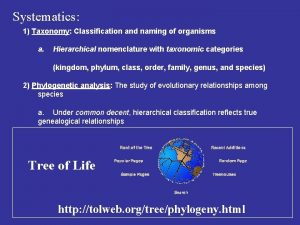UNIT 7 PLANT ANIMAL TAXONOMY SYSTEMATICS PHYLOGENY CHAPTER








- Slides: 8

UNIT 7: PLANT & ANIMAL TAXONOMY SYSTEMATICS & PHYLOGENY CHAPTER 19 p. 337 - 351

1. SYSTEMATICS � SYSTEMATICS – involves the RECONSTRUCTING of EVOLUTIONARY HISTORY and then CLASSIFYING or grouping organisms according to evolutionary findings. � It is dedicated to understanding the evolutionary history of life on earth. � Comes from the Greek word SYSTEMA which means an orderly arrangement. � It is analytical and relies on a combination of data from the FOSSIL RECORD and COMPARITIVE ANATOMY and DEVELOPMENT, with an emphasis on MOLECULAR DATA – to determine evolutionary relationships.

2. TAXONOMY forms part of SYSTEMATICS. Comes from the Greek words: TASSO – arrange/classify and NOMOS – use/law. Taxonomy concerned with IDENTIFYING, NAMING & CLASSIFYING organisms. ARISTOTLE – one of the first taxonomists – he identified organisms as belonging to a particular group. LATIN is the language used for SCIENTIFIC NAMES of organisms.

BINOMIAL SYSTEM � CAROLUS LINNAEUS was seen as the father of taxonomy in the 17 th century & developed a BINOMIAL NOMENCLATURE by which each species receives a TWO PART NAME. � The first part is the GENUS NAME, this is a category that can contain many species. � The second part is the SPECIFIC EPITHET which refers to one species within that genus – the specific epithet tells us something descriptive about the organism, like the colour, geographical description. It can also be an EPONYM – named after someone or some mythical character.

The GENUS name is always CAPITALIZED, but not the species name. When written, the genus and species name is UNDERLINED and when typed it is indicated in italics e. g. Lilium canadense.

WHY DO ORGANISMS NEED SCIENTIFIC NAMES? �There are several reasons: � - A common name will vary from country to country because different countries use different languages. � - Even people who speak the same languages sometimes use different common names to describe the same organism. � For example: Bowfin, Grindle and Cypress trout describe the same common fish, Amia calva. � Furthermore, between countries, the same common name is sometimes given to different organisms. A “robin” in England is very different from a “robin” in the United States.

WHY DO SCIENTISTS USE LATIN? � Latin – is a universal language that not too long ago was well known by most scholars (Physicians). � When scientists throughout the world use the same scientific binomial name, they know they are speaking of the same organism. � The Linnean Society rules on the appropriateness of the binomial name for each species in the world. � Of the estimated 3 -30 million species now living on Earth, a million species of animals and half a half million species of plants and microorganisms have been named.

DNA A new fast and efficient way of identifying species is based on their DNA.














